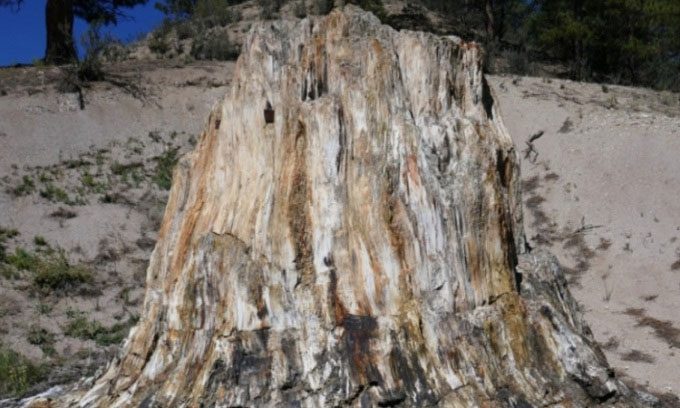The forest consists of 400 fossilized tree stumps covering an area of 2,000m2 and primarily belongs to the same tree species.
A rare fossilized forest located on the Kiso River northeast of Nagoya is providing scientists with a closer look at reconstructing the entire flora of the Eurasian continent from the late Middle Triassic period, filling one of many gaps in the tree of life, Science Alert reported on July 25. The late Middle Triassic period lasted from approximately 10.4 to 5 million years ago.

A fossilized tree stump from ancient times. (Photo: David Johnson/iStock).
The forest was first discovered in modern times during a severe drought in 1994, when 400 fossilized tree stumps emerged from the water. Most of the stumps sank again, but researchers successfully examined 137 stumps and fossilized leaves in the surrounding area. They published their analysis results and described the tree species that once covered the forest in the journal Scientific Reports.
Unlike animals, parts of plants, whether seeds, leaves, or fruits, typically detach from the tree during their life cycle, making complete fossils extremely rare. As a result, when it comes to plant fossils, scientists often assign different scientific names to various parts (leaves, fruits, or trunks) even if they belong to the same species. Identifying which species the fossils of trunks and leaves belong to is a significant challenge.
The forest in Nagoya provides an excellent research opportunity because only one type of trunk and leaf is commonly found in the area. Of the 137 tree stumps the research team examined, 130 belonged to the species Wataria parvipora. “Wataria is a wood fossil, identified by its characteristic growth rings, numerous parenchyma rays, and few resin ducts,” said the lead researcher Toshihiro Yamada, a biologist at Hokkaido University. “In the 2,000m2 fossil area, these stumps make up 95% of the remains, indicating that we discovered a forest dominated by Wataria parvipora.”
The largest fossilized tree stump has a diameter of 137cm. The majority of leaves found in the vicinity belong to Byttneriophyllum tiliifolium, a fossilized leaf species related to modern plants such as cotton, cacao, and okra. This leaf fossil has been found across the Eurasian continent during the Middle and Late Triassic periods.
“We found 98% of the leaf fossils in the area belong to Byttneriophyllum, indicating they fell from the parent tree,” Yamada said. “We can see leaves scattered all over the forest floor and fossilized where they fell.”
Previous research linked a type of fossilized fruit named Banisteriocarpon giganteum with the leaves of B. tiliifolium. Future studies will focus on searching for traces of fruit in Japan to connect the trunk, fruit, and leaves into a complete tree.


















































